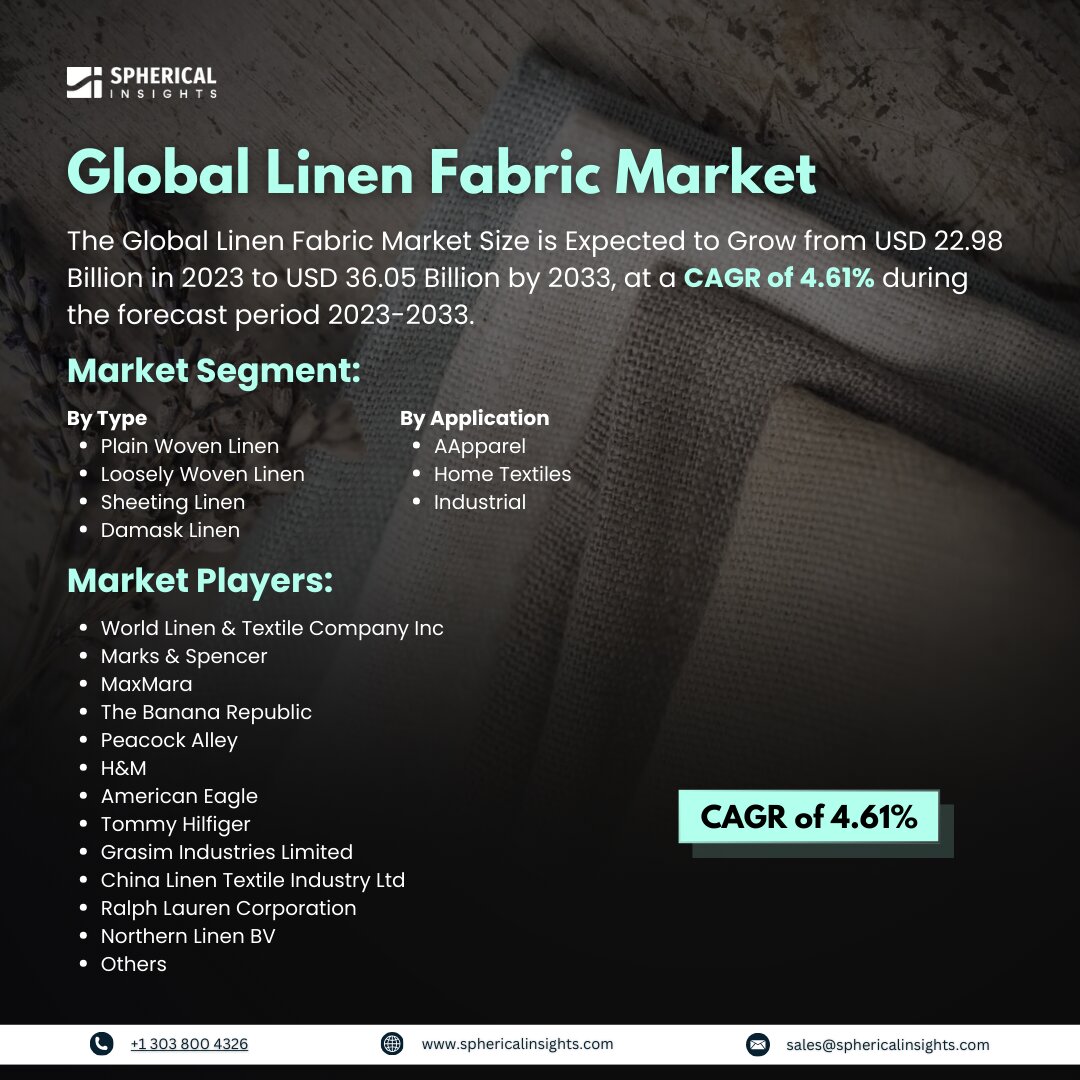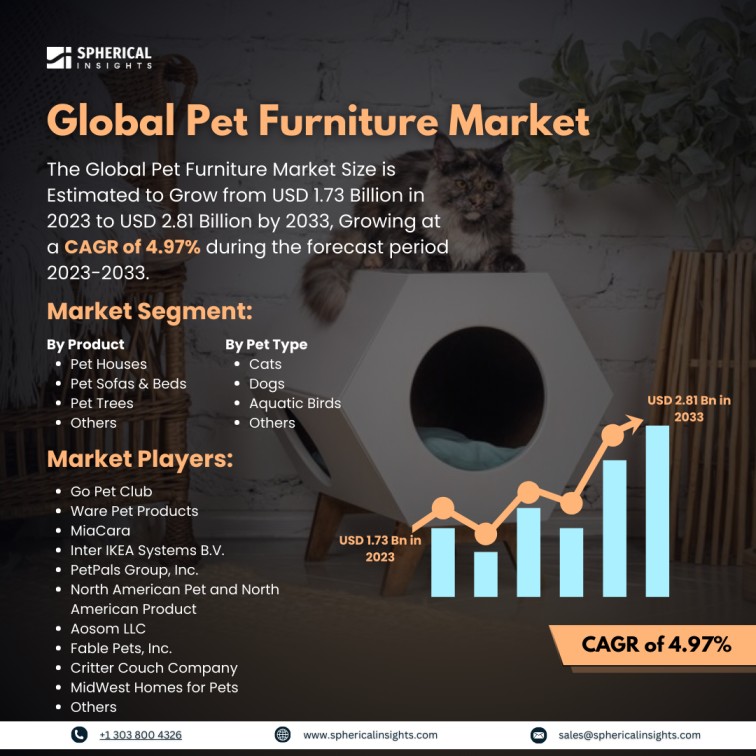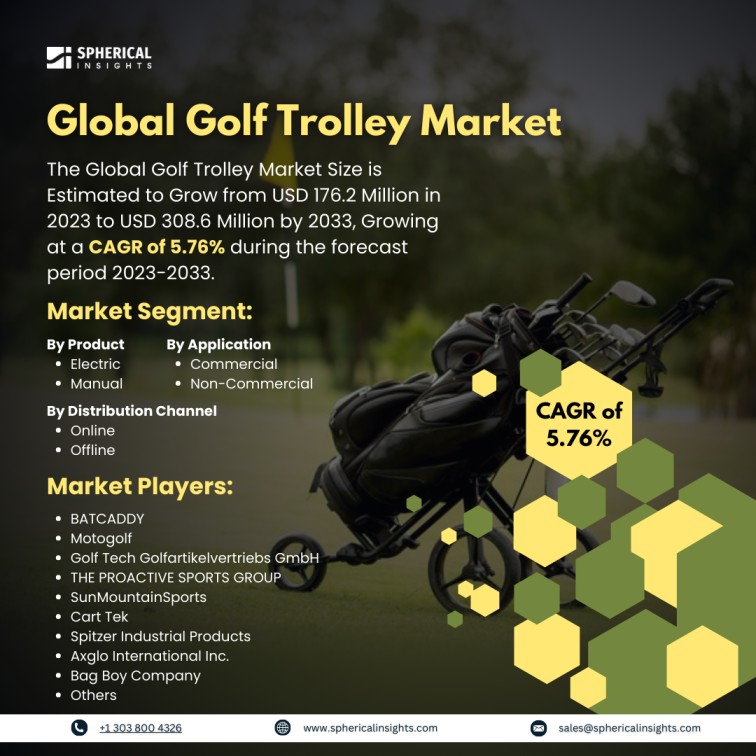Global Linen Fabric Market Size to Exceed USD USD 36.05 Billion by 2033
According to a research report published by Spherical Insights & Consulting, the Global Linen Fabric Market Size is Expected to Grow from USD 22.98 Billion in 2023 to USD 36.05 Billion by 2033, at a CAGR of 4.61% during the forecast period 2023-2033.
Browse 210 market data Tables and 45 Figures spread through 190 Pages and in-depth TOC on the Global Linen Fabric Market Size, Share, and COVID-19 Impact Analysis, By Type (Plain Woven Linen, Loosely Woven Linen, Sheeting Linen, and Damask Linen), By Application (Apparel, Home Textiles, and Industrial), and By Region (North America, Europe, Asia-Pacific, Latin America, Middle East, and Africa), Analysis and Forecast 2023 – 2033
The manufacture, distribution, and retailing of linen fabric which is derived from the fibers of the flax plant are all part of the worldwide linen fabric market. Bedsheets, towels, and tablecloths are examples of textiles created from the fibers of the flax plant, which is known as linen fabric. The natural fibers of flax plants are used to make linen. It contains robust fibers with absorbing properties and a rapid drying rate. It is used in a variety of home furnishings the most. Additionally, the extreme comfort that linen clothing offers due to its rapid absorption and removal of perspiration is the driving force behind the linen apparel industry. Clothing made of linen is worn as lifestyle apparel and is considered to be of superior quality. The fashion industry's expansion, particularly in developing countries with increasing disposable means, is driving up demand for linen, making it a preferred fabric for fashion clothing, particularly in hot and muggy climates. Therefore, it is projected that during the forecast period, the growing use of linen as a fabric for apparel would increase product demand. However, the lack of elasticity in linen fabric, which leads to threads breaking when folding or creasing at the same spot, and the expensive cost of linen items relative to other materials limit the market's growth.
The plain woven linen segment held the highest share in 2023 and is anticipated to grow at a significant CAGR during the projected timeframe.
Based on type, the global linen fabric market is categorized as plain woven linen, loosely woven linen, sheeting linen, and damask linen. Among these, the plain woven linen segment held the highest share in 2023 and is anticipated to grow at a significant CAGR during the projected timeframe. This fabric typically features a checkered or striped design on a white background that is either red, blue, or both. Because of its loose weave, this kind of linen cloth is very absorbent and ideal for cleaning, but it is also marginally less durable.
The apparel segment held the highest share in 2023 and is anticipated to grow at a significant CAGR during the projected timeframe.
Based on the application, the global linen fabric market is categorized as apparel, home textiles, and industrial. Among these, the apparel segment held the highest share in 2023 and is anticipated to grow at a significant CAGR during the projected timeframe. This is due to the growing need for breathable and environmentally friendly apparel fabrics. For clothing like shirts, skirts, and slacks, linen's inherent moisture-wicking qualities are perfect.
North America is projected to hold the largest share of the global linen fabric market over the forecast period.
North America is projected to hold the largest share of the global linen fabric market over the forecast period. The comfort and adaptability of linen garments have led to its growing appeal in North America, which is driving market expansion. Because of its inherent beauty and longevity, linen is also in high demand in this area for home textiles including upholstery, towels, and bed linens. Trends in the fashion business are also quite important. As natural and sustainable textiles become more popular, linen is becoming a popular option for both designers and customers in North America.
Asia Pacific is expected to grow at the fastest CAGR growth of the global linen fabric market during the forecast period. In regions like the Asia Pacific that have hot, humid climates, linen fabrics are quite popular. The worldwide market for linen fabrics is being driven by the textiles' many benefits, including its smoothness, coolness, lack of lint, and softer texture with time. The worldwide linen fabric market is also being boosted by the usage of linen fabric as a fashion statement and stylish accessories in developing nations like China & India.
Competitive Analysis
Major vendors in the global linen fabric market are World Linen & Textile Company Inc, Marks & Spenser, MaxMara, The Banana Republic, Peacock Alley, H&M, American Eagle, Tommy Hilfiger, Grasim Industries Limited, China Linen Textile Industry Ltd, Ralph Lauren Corporation, Northern Linen BV, and Others.
Key Target Audience
- Market Players
- Investors
- End-users
- Government Authorities
- Consulting and Research Firm
- Venture capitalists
- Value-Added Resellers (VARs)
Market Segment
This study forecasts revenue at global, regional, and country levels from 2020 to 2033. Spherical Insights has segmented the global linen fabric market based on the below-mentioned segments:
Global Linen Fabric Market, By Type
- Plain Woven Linen
- Loosely Woven Linen
- Sheeting Linen
- Damask Linen
Global Linen Fabric Market, By Application
- AApparel
- Home Textiles
- Industrial
Global Linen Fabric Market, By Regional
- North America
- Europe
- Germany
- UK
- France
- Italy
- Spain
- Russia
- Rest of Europe
- Asia Pacific
- China
- Japan
- India
- South Korea
- Australia
- Rest of Asia Pacific
- South America
- Brazil
- Argentina
- Rest of South America
- Middle East & Africa
- UAE
- Saudi Arabia
- Qatar
- South Africa
- Rest of the Middle East & Africa



